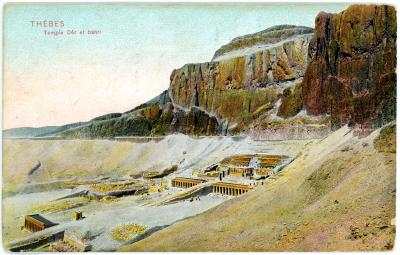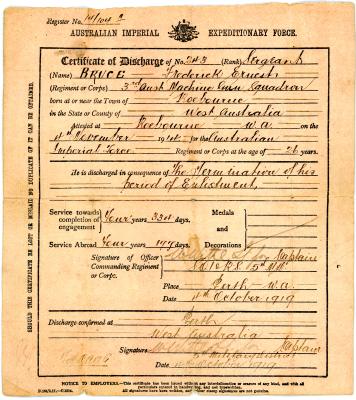Trench Art Pendant of Sergeant Frederick Ernest BRUCE 243
c. 1915A small white metal pendant with the raised relief of a horseshoe around a raised map of Australia. The horseshoe has three (3) mock nails on each of its sides, with an inverted triangle design at the center top of the shoe. There is engraving on the map of Australia and at the bottom of the pendant. The back is a plain piece of metal of the same shape as the front, attached to make a fixing for a chain.
A personalised identity disc made for Private Frederick Ernest BRUCE 243. Frederick came from Cossack in the north of Western Australia and enlisted on 4 November 1914. He joined 10th Light Horse Regiment as a Private and his unit sailed from Fremantle aboard the HMAT A47 Mashobra on 17 February 1915. He served at Gallipoli and then in Palestine. He was promoted to Sergeant in January 1918 and returned to Australia on 10 July 1919. The engravings include the Australian Machine Gun Squadron (AMGS) and his religion as Church of England (CE).
Details
Details
“243 / F. E. BRUCE / 3RD A.M.C.S. CE / Gallipoli / 1915”
In August 1914, orders were circulated that each man wear an identity disc showing his name, number (if relevant), unit, and religion. In late 1916 Australia adopted the British regulation from Army Order 287 (published as Military Order 507 by the AIF) to issue each member of the AIF with two discs, both made of compressed fibre: an octagonal green disc (formally referred to as “Disc, identity, No. 1, green”), and a circular red disc (formally referred to as “Disc, identity, No.2, red”).
In late 1917 a number of Australian newspapers published an article titled “Soldier’s Fears”, which noted: ‘Many soldiers have a horror of losing their identity discs, or of being unidentified if they are killed, and buried in a nameless grave. One man is known to carry little scraps of paper in every pocket, giving his name and regiment, so that his body may be recognised if he is killed.’ Given that it was over two years from the declaration of war until the Department of Defence finally ordered two discs be worn, this fear could have contributed to large numbers of Australians wearing unofficial commercially produced or improvised identity discs in addition to their officially issued disc. Discs made from ground down foreign coins were particularly popular, as were identity bracelets.
Open in Google Maps
Nearest geotagged records:
- Invalid Cup (0km away)
- Peter LONEY Letter (0km away)
- Ellis SILAS Water Colour Painting (0km away)
- Engraved Japanese Water Bottle belonging to Robert George Staunton RENNIE WX7493 (0km away)
- Enlistment Poster (0km away)
- W. D. & H. O. Wills Lace Flag Cigarette Cards (0km away)
- First world War Picture Postcard (0km away)
- Photograph of the Japanese surrender to Australia on 13 September 1945. (0km away)
- Engraved Tin given to Major Arthur Robinson HOME WX11151 (0km away)
- Martini-Henry action (0km away)
Nearby places: View all geotagged records »
Princess Royal Fortress Military Museum
Princess Royal Fortress Military Museum
Other items by Frederick Ernest BRUCE
More items like this
Other items from Princess Royal Fortress Military Museum
- First World War Medal Trio of Pte. William John BEER 1509
- Pair of Standard Issue Spurs of Sergeant Frederick Ernest BRUCE 243
- First World War Princess Mary Gift Tin
- 1908 Belgium 25 Centimes Pierced Coin Sergeant Frederick Ernest BRUCE 243
- Framed Marriage Photograph Sergeant Frederick Ernest BRUCE and Elsie Eva BRUCE (nee HARRIS)
- First World War Certificate of Discharge Sergeant Frederick Ernest BRUCE 243
- 'Weapons of Precision' Metal Tin used by Private William John BEER 512
- First World War Cut Throat Razor “The Clinker” used by Private William John BEER 1509
- First World War 'Kropp' Cut Throat Razor used by Private William John BEER 1509
- First World War T. R. Cadman & Sons Cut Throat Razor used by Private William John BEER 1509
- First World War Medal Trio Ribbon Bar of Pte. William John BEER 1509
- First World War Cut Throat Razor used by Private William John BEER 1509
Scan this QR code to open this page on your phone ->


